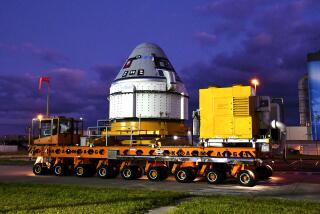Hearings to Focus on Thiokol Engineers
- Share via
BRIGHAM CITY, Utah — When the space shuttle Challenger took off on a chilly Florida morning, one Morton Thiokol Inc. rocket expert refused to watch the launch on television. He was afraid of what he might see.
Fifteen hours earlier, he had been one of several Thiokol engineers who had strenuously argued that the launch should be delayed until temperatures rose. Although the argument had been lost with NASA and the management at Thiokol, on the fateful morning he was still making his case to colleagues that the integrity of the rubber seals on the Challenger’s solid rocket boosters might be compromised by the severe cold.
The conversation was interrupted by another engineer who burst in with the news: Challenger had blown up.
Commission Inquiry
The concerns of this engineer and others, disclosed by Thiokol sources who requested anonymity, will be the focus of public hearings today and Wednesday in Washington before the presidential commission investigating the shuttle disaster.
The hearings are expected to provide the first inside view of the behind-the-scenes, launch-eve dispute, in which one National Aeronautics and Space Administration official criticized the advocates of delay, saying: “My God, Thiokol! When do you want me to launch--next April?”
The engineers who opposed the cold-weather launch were members of a special company task force created a year earlier to examine problems with rocket seals after several were damaged during a January, 1985, low-temperature launch.
That group--Thiokol’s “O-ring Task Force”--had developed 43 separate recommendations for engineering or design changes on the critical O-ring seals, many of which were rejected for a variety of reasons, according to one engineer. However, some of the recommendations reportedly remained under consideration by NASA at the time of Challenger’s launch.
Failure Suspected
The O-rings are common rubber seals--like huge washers--that fit between each of the four segments of a 149-foot-tall solid rocket booster. The seals are supposed to prevent 6,000-degree exhaust gases from escaping. A failure of one of those seals in the right rocket booster is suspected of causing the catastrophic explosion that destroyed Challenger on Jan. 28.
The task force was formed after seals examined from a rocket booster recovered after a shuttle launch in 53-degree weather--the previous record low for a launch--showed damage to half the seals.
Although Thiokol officials declined response to inquiries about the task force, it was learned from interviews with engineers that among the task force’s “dozen or so” members were engineers Allan J. McDonald and Roger Boisjoly.
It was McDonald who, as the Morton Thiokol representative at the Kennedy Space Center, refused to sign a consent form giving the company’s authorization to launch Challenger. The form instead had to be signed by a Morton Thiokol vice president, Joe C. Kilminster, in Brigham City, and wire-transferred to Florida. And Boisjoly--who a colleague said regarded the task force as “his baby”--was reportedly among the most outspoken opponents of the cold-temperature launch during the angry telephone conference with NASA.
Lower Readings
The widely held engineering concerns apparently centered solely around the near-freezing temperatures at Cape Canaveral. What Thiokol engineers--and the four-man management team that overruled their warnings--reportedly did not know was that the temperature measurements taken the morning of Jan. 28 by NASA’s ice team revealed dramatically lower readings on parts of the right rocket booster, readings as low as minus 7 degrees, according to some accounts.
“If anybody had known that, we’d have blown the whistle so fast . . . “ one Thiokol engineer said.
The aftermath of the crash brought “a lot of panic” among Morton Thiokol’s management, one engineer said. “In the first week, we had 30 or 40 people coming down (to the engineering departments) every day, all asking us to do the same things. It’s better organized now, but there’s still a lot of fear,” he said.
More to Read
Sign up for Essential California
The most important California stories and recommendations in your inbox every morning.
You may occasionally receive promotional content from the Los Angeles Times.













